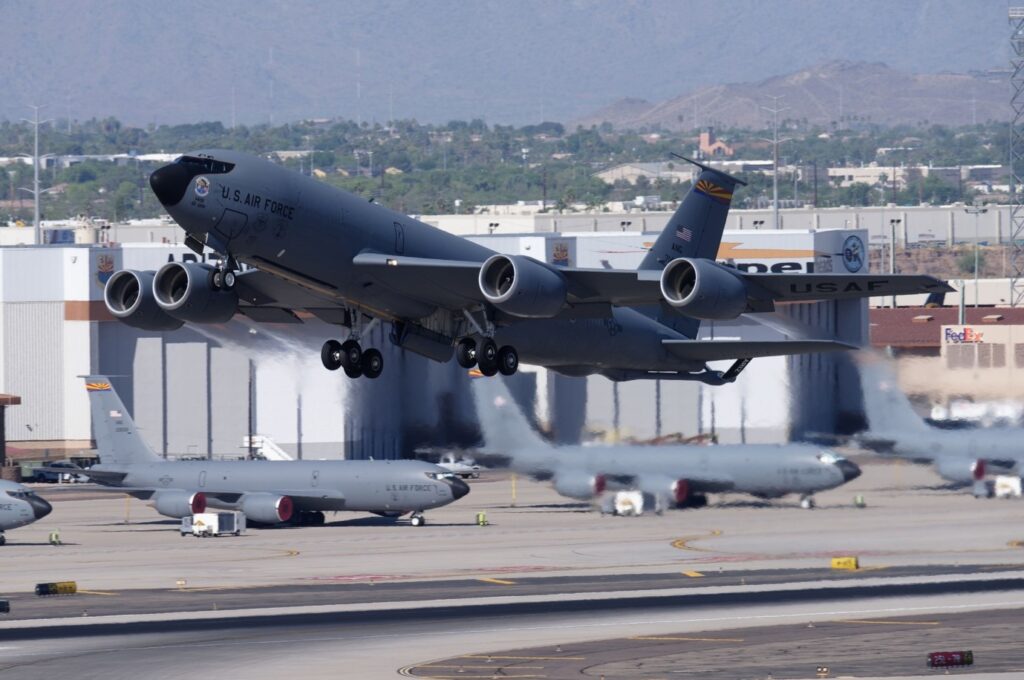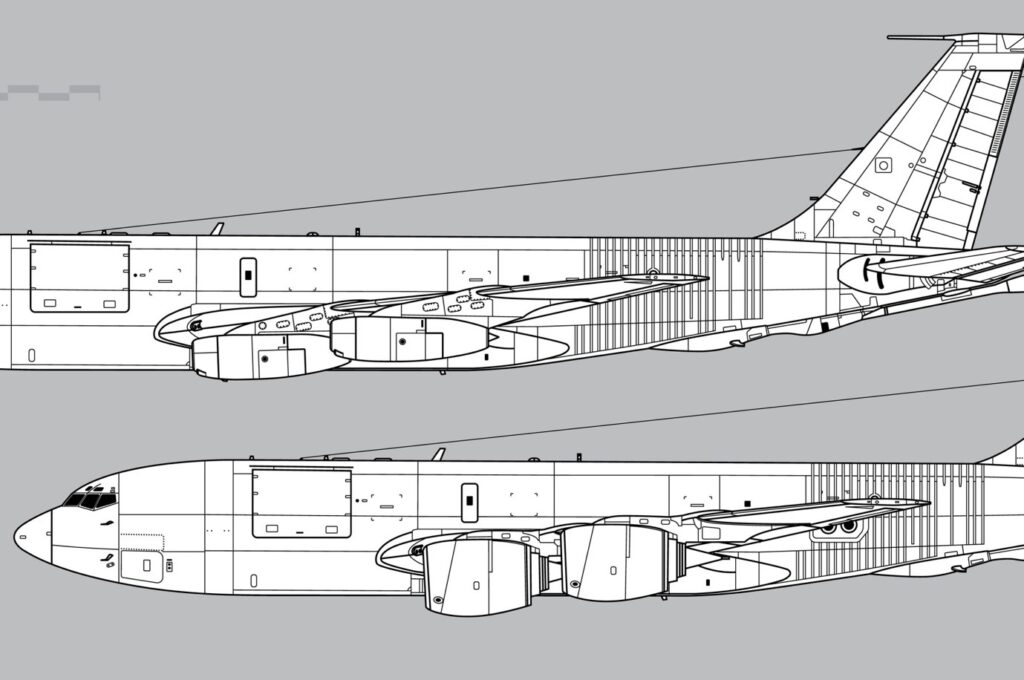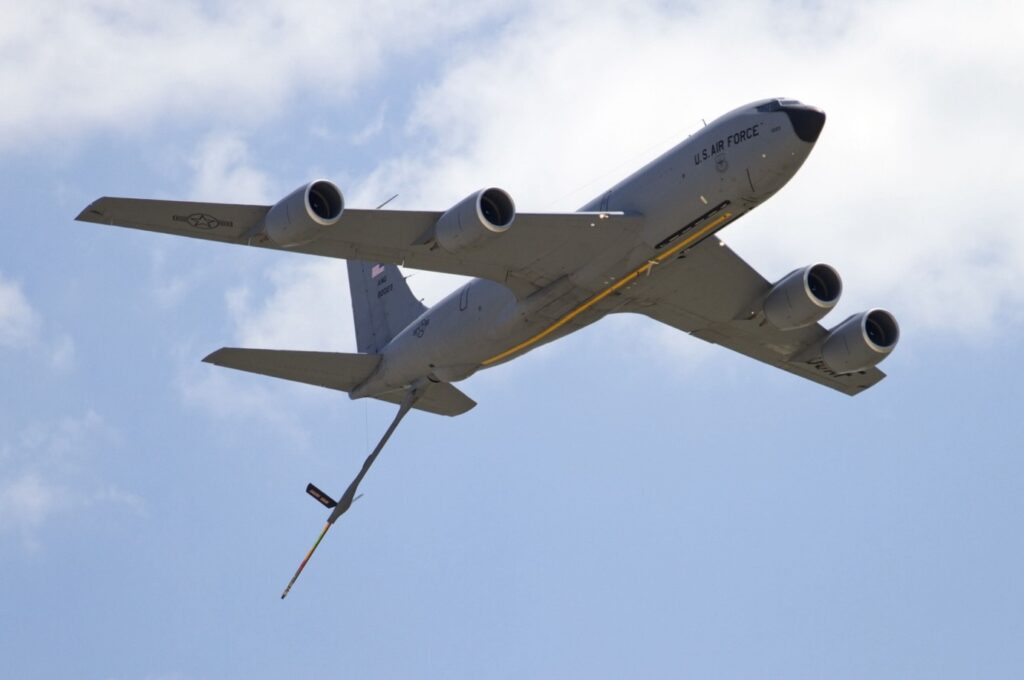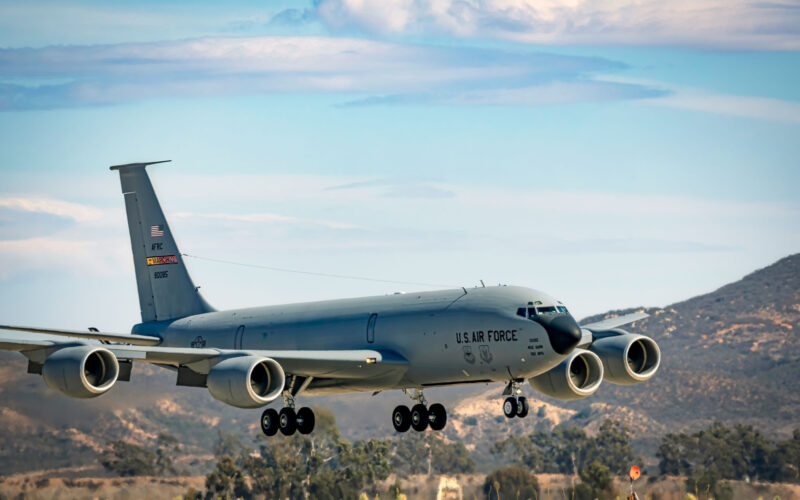The Boeing KC-135 Stratotanker is a military asset that has served as the backbone of the United States Air Force‘s (USAF’s) aerial refueling fleet for over six decades. It is a versatile aircraft that plays a crucial role in extending the operational range of military jets, enabling them to conduct long-range missions without the need for frequent refueling stops.
The KC-135 Stratotanker has a rich history, plus advanced avionics, unique mission capabilities, and a distinctive design, making it an indispensable asset in military operations worldwide.
History
The creation of the KC-135 Stratotanker dates back to the early 1950s when USAF recognized the need for a dedicated aerial refueling aircraft. Boeing was awarded a contract in 1954 to develop the KC-135, based on the design of the Boeing 367-80, which eventually evolved into the famous Boeing 707 airliner.
The first produced KC-135A Stratotanker made its maiden flight on August 31, 1956, and it entered service with the USAF in June 1957.

KC-135 Stratotanker’s mission
The primary mission of the KC-135 Stratotanker is aerial refueling. Equipped with an extendable flying boom, the aircraft can transfer fuel to other aircraft in flight, including fighters, bombers and reconnaissance planes.
This capability significantly enhances the range, endurance and flexibility of military aircraft, allowing them to stay airborne for longer periods and reach distant targets without the need for additional refueling stops. Additionally, the KC-135 can transport passengers and cargo when necessary, making it a multi-role asset.
Features and design
The KC-135 Stratotanker has a highly distinctive design, with swept wings and four turbofan engines mounted under the wings. The aircraft has a robust airframe that allows it to withstand the stresses of air-to-air refueling operations. It can carry up to 200,000 pounds (90,718 kilograms) of fuel, stored in tanks located in the wings and center fuselage. The extendable flying boom, located at the rear of the aircraft, is controlled by a boom operator, who guides it into the receiving aircraft for fuel transfer.

Avionics
Over the years, the avionics systems on the KC-135 Stratotanker have undergone significant upgrades to keep pace with technological advancements. Nowadays, the aircraft features advanced navigation and communication systems, including inertial navigation, global positioning systems (GPS), and secure communication equipment.
The latest upgrade, the Block 45 program from 2016, involved replacing analog instruments with a new glass cockpit digital display, radio altimeter, digital autopilot, digital flight director, and computer updates. This upgrade improves functionality and brings the KC-135 in line with modern avionics standards.
Technical specifications of KC-135R
| Specification | Details |
| Length | 136 ft 3 in (41.53 m) |
| Wingspan | 130 ft 10 in (39.88 m) |
| Height | 41 ft 8 in (12.70 m) |
| Fuel Capacity | 200,000 lb (90,718 kg) |
| Maximum Takeoff Weight | 322,500 lb (146,284 kg) |
| Maximum Speed | 504 knots (6580 mph, 933 km/h, Mach 0.9) |
| Range | 1,303 nautical miles (2,414 km) with 150,000 lb (68,039 kg) of fuel |
| Engines | Four CFM International CFM56 turbofans, 21,600 lbf (96.2 kN) thrust each |
| Crew | Three (pilot, co-pilot, boom operator and in some missions a navigator) |
| Capacity | up to 80 passengers, 83,000 lb (38,000 kg) or 6 (463L) master pallets |
| Service Ceiling | 50,000 ft (15,000 m) |
Variants
The KC-135 Stratotanker has several variants, each with specific modifications to fulfill various mission requirements.
Some of its notable variants include:
Boeing EC-135
The Boeing EC-135 was an airborne command post and communications relay aircraft. The aircraft was introduced in 1965 and retired in 2000. It was specifically designed to provide strategic command and control capabilities during critical situations. The EC-135 was equipped with advanced communication systems, allowing it to function as a mobile command center and coordinate operations in the air. It played a vital role in ensuring effective communication and decision-making capabilities for military leaders.
Boeing NC-135
The Boeing NC-135 is a variant of the KC-135 that was modified for special test and evaluation purposes. It serves as a testbed for various systems and technologies, allowing researchers and engineers to conduct experiments and gather data in flight. The NC-135 is used for testing new avionics, sensors and other equipment that would later be incorporated into other aircraft.
Boeing OC-135B Open Skies
The Boeing OC-135B Open Skies aircraft was part of an international program known as the Open Skies Treaty. Boeing OC-135B was introduced in 1993 and retired in 2021. It was used for unarmed observation flights over the territories of participating countries to promote transparency and confidence-building measures. The OC-135B was equipped with specialized cameras and sensors to capture imagery and data during these observation missions, ensuring compliance with the treaty.
Boeing RC-135
The Boeing RC-135 is a family of reconnaissance aircraft used by the USAF for intelligence gathering and surveillance missions. The RC-135 variants are equipped with advanced sensor suites, communication systems, and mission-specific equipment to perform their roles effectively. They are used for signals intelligence (SIGINT), electronic intelligence (ELINT), and other reconnaissance missions, providing critical information for military intelligence purposes.
Boeing WC-135 Constant Phoenix
The Boeing WC-135 Constant Phoenix is a specialized aircraft used for atmospheric sampling and monitoring. It is designed to detect and analyze atmospheric particles and gases, including radioactive isotopes, as part of its role in the detection of nuclear explosions. The WC-135 is equipped with specialized equipment and sensors to collect air samples and provide data for analysis, helping to ensure compliance with international arms control treaties.
A330 MRTT/KC-30A Voyager
The A330 MRTT, also knows as KC-30A Voyager is a next-generation aerial tanker and transport aircraft based on the Airbus A330 airliner. It is primarily used for aerial refueling, allowing it to extend the operational range and endurance of other military aircraft, such as fighter jets, bombers, and reconnaissance planes. Additionally, it serves as a multi-role transport aircraft capable of carrying passengers, cargo, and performing medical evacuation missions.
Operators and uses
The KC-135 Stratotanker is primarily operated by the USAF. It serves as a critical asset for the USAF’s Air Mobility Command, providing aerial refueling support to a wide range of military aircraft. In addition to the USAF, several other countries, including France, Turkey, and Chile, still operate KC-135 Stratotankers or derivatives, further highlighting the aircraft’s international significance.

Unit cost
The unit cost of a KC-135 Stratotanker varies depending on the specific variant and configuration. In September 2021, the approximate cost of a new KC-135R was around $62.2 million.
Future ahead
While the KC-135 Stratotanker has been a workhorse for many decades, its age and the evolving operational requirements of modern air forces have prompted the development of next-generation aerial refueling platforms. Efforts are underway and new, advanced tanker aircraft, such as the Boeing KC-46 Pegasus will gradually replace the aging KC-135 fleet. The U.S. military has already placed an order for 179 KC-46A Pegasus aircraft, which will be delivered gradually by 2027.
However, the KC-135 is expected to remain in service for the foreseeable future, fulfilling critical aerial refueling needs until the transition to newer platforms is complete.

